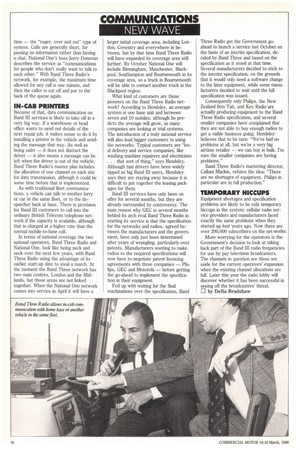COMMUNICATIONS NEW WAVE
Page 46

If you've noticed an error in this article please click here to report it so we can fix it.
time — the "roger, over and out" type of system. Calls are generally short, for passing on information rather than having a chat. National One's boss Jerry Donovan describes the service as "communications for people who don't really want to talk to each other." With Band Three Radio's network, for example, the maximum time allowed for any call is one minute, and then the caller is cut off and put to the back of the queue again.
Because of that, data communication on Band III services is likely to take off in a very big way. If a warehouse or head office wants to send out details of the next repair job, it makes sense to do it by installing a printer in the vehicle and sending the message that way. As well as being safer — it does not distract the driver — it also means a message can be left when the driver is out of the vehicle. Band Three Radio's master plan includes the allocation of one channel on each site for data transmission, although it could be some time before that is implemented.
As with traditional fleet communications, a vehicle can talk to another lorry or car in the same fleet, or to the despatcher back at base. There is provision for Band III customers to call into the ordinary British Telecom telephone network if the capacity is available, although that is charged at a higher rate than the normal mobile-to-base call.
In terms of national coverage the two national operators, Band Three Radio and National One, look like being neck and neck over the next few years, with Band Three Radio using the advantage of its earlier start-up date to steal a march. At the moment the Band Three network has two main centres, London and the Midlands, but those areas are not linked together. When the National One network comes into service in April it will have a larger initial coverage area, including London, Coventry and everywhere in between, but by that time Band Three Radio will have expanded its coverage area still further. By October National One will include Birmingham, Manchester, Blackpool, Southampton and Bournemouth in its coverage area, so a truck in Bournemouth will be able to contact another truck in the Blackpool region.
What kind of customers are those pioneers on the Band Three Radio network? According to Hendsley, an average system is one base unit and between seven and 10 mobiles, although he predicts the average will grow, as many companies are looking at trial systems. The introduction of a truly national service will also lead bigger customers to using the networks. Typical customers are "local delivery and service companies', like washing machine repairers and electricians . . . that sort of thing," says Hendsley. Although taxi drivers have been widely tipped as big Band III users, Hendsley says they are staying away because it is difficult to put together the leasing packages for them.
Band III services have only been on offer for several months, but they are already surrounded by controversy. The main reason why GEC is several months behind its arch rival Band Three Radio in starting its service is that the specification for the networks and radios, agreed between the manufacturers and the government, have only just been determined after years of wrangling, particularly over patents. Manufacturers wanting to make radios to the required specifications will now have to negotiate patent licencing agreements with three companies — Philips, GEC and Motorola — before getting the go-ahead to implement the specification in their equipment.
Fed up with waiting for the final machinations over the specification, Band Three Radio got the Government goahead to launch a service last October on the basis of an interim specification, decided by Band Three and based on the specification as it stood at that time. Several manufacturers decided to stick to the interim specification, on the grounds that it would only need a software change to the later equipment, while some manufacturers decided to wait until the full specification was issued.
Consequently only Philips, the New Zealand firm Tait, and Key Radio are actually producing equipment to the Band Three Radio specification, and several smaller companies have complained that they are not able to buy enough radios to get a viable business going. Hendsley believes that to be ture: "We've had no problems at all, but we're a very big airtime retailer — we can buy in bulk. I'm sure the smaller companies are having problems."
Band Three Radio's marketing director, Callum Mackie, refutes the idea: "There are no shortages of equipment. Philips in particular are in full production."
Equipment shortages and specification problems are likely to be only temporary hiccups in the system: cellular radio service providers and manufacturers faced exactly the same problems when they started up four years ago. Now there are over 200,000 subscribers on the net-works.
More worrying for the operators is the Government's decision to look at taking back part of the Band III radio frequencies for use by pay television broadcasters. The channels in question are those set aside for the current operators' expansion when the existing channel allocations are full. Later this year the radio lobby will discover whether it has been successful in seeing off the broadcasters' threat.
by Della Bradshaw








































































































